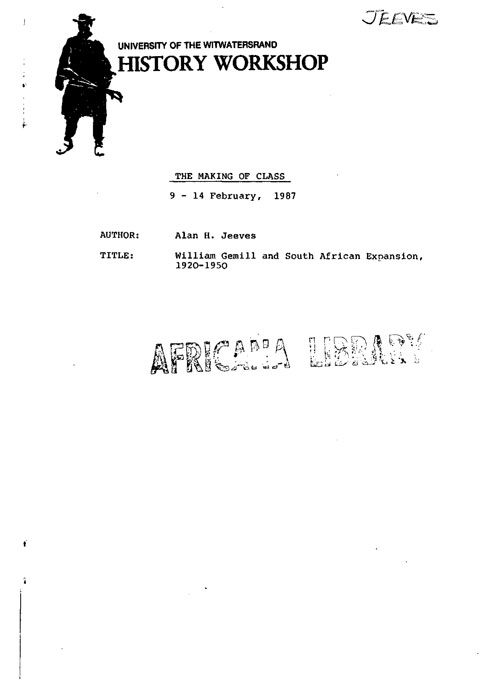For the descendents of Richard Dearie and his son John Russell
UNIVERSITY OF THE WITWATERSRAND HISTORY WORKSHOP
THE MAKING OF CLASS
9-14 February, 1987
AUTHOR: Alan H. Jeeves
TITLE: William Gemill and South African Expansion, 1920-1950
AFRICANA LIBRARY
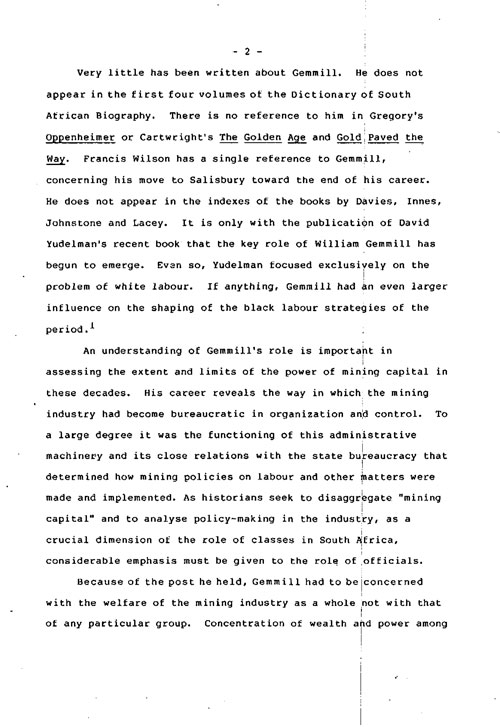
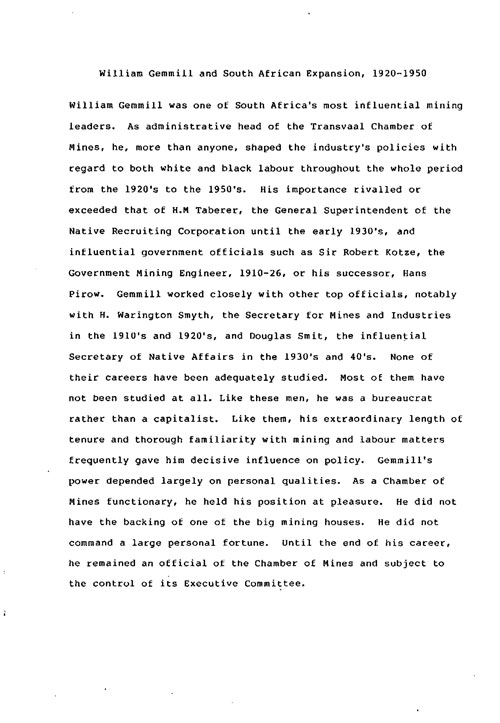
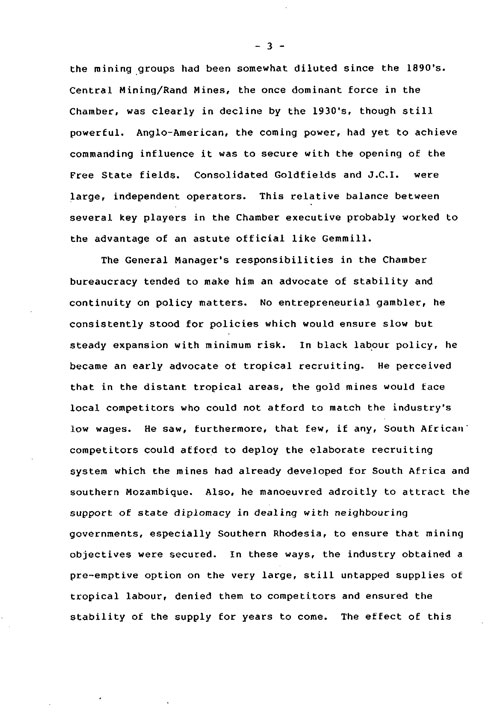

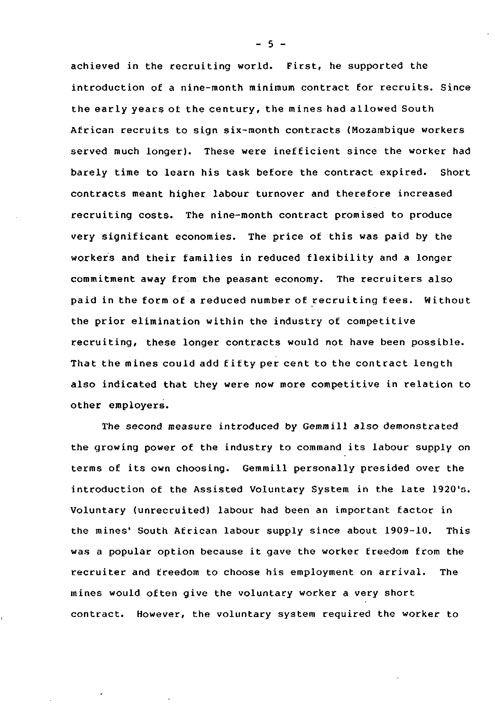
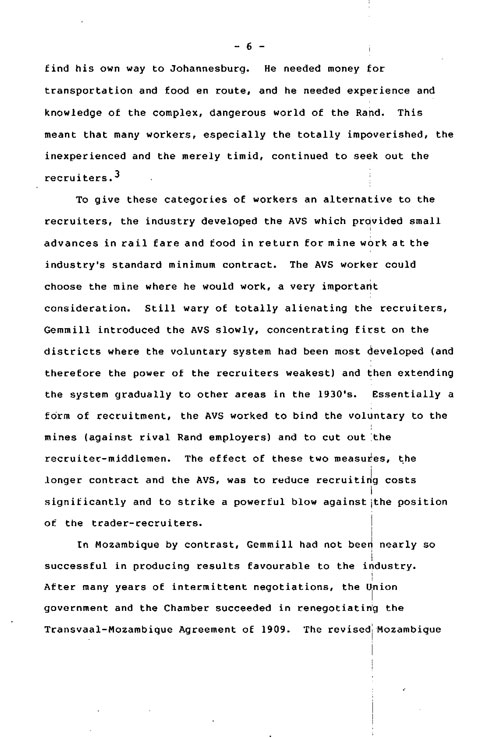
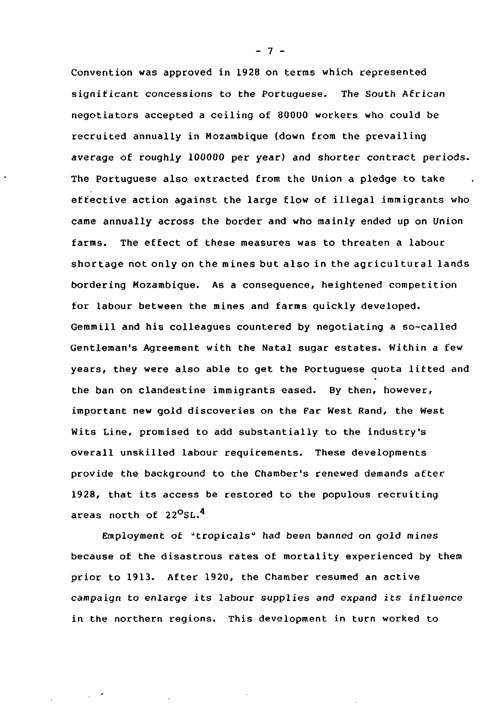
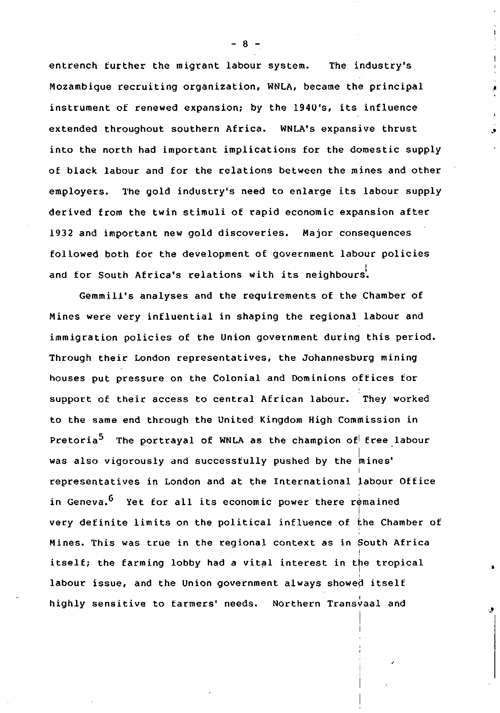

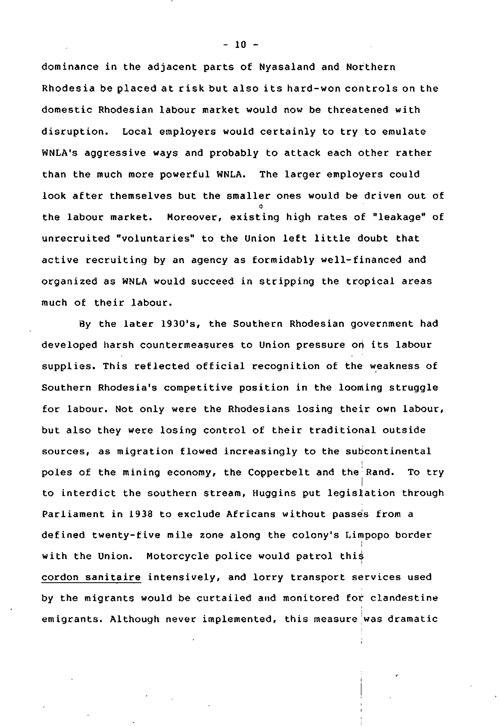
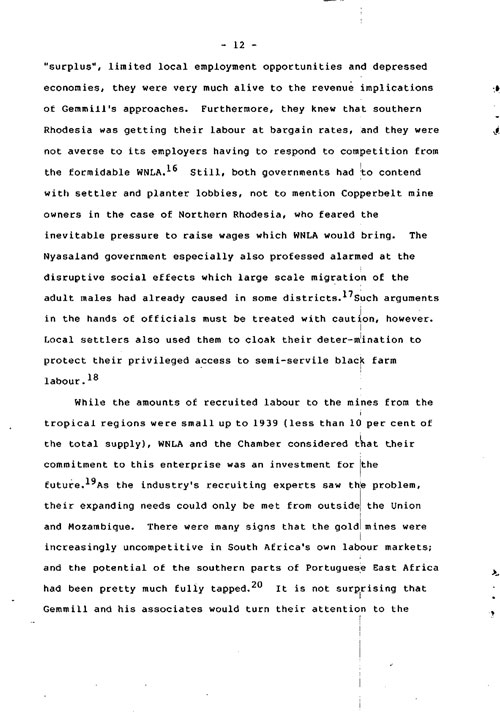

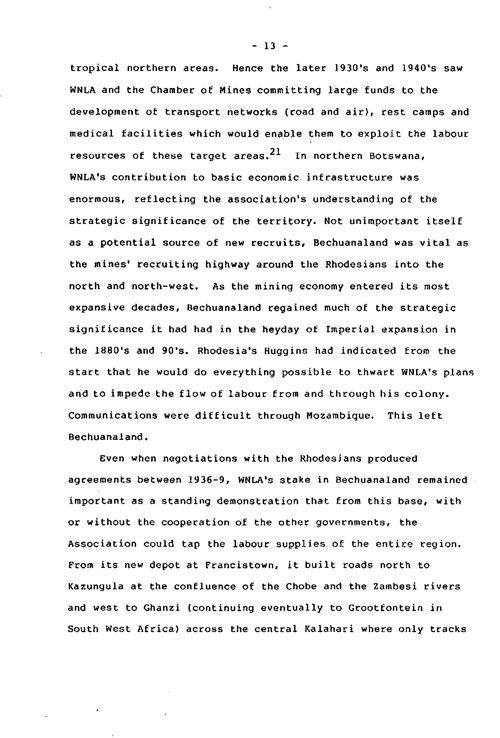

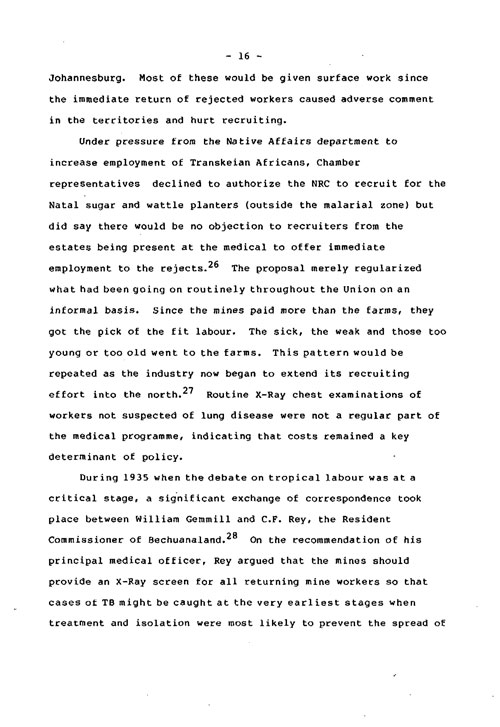




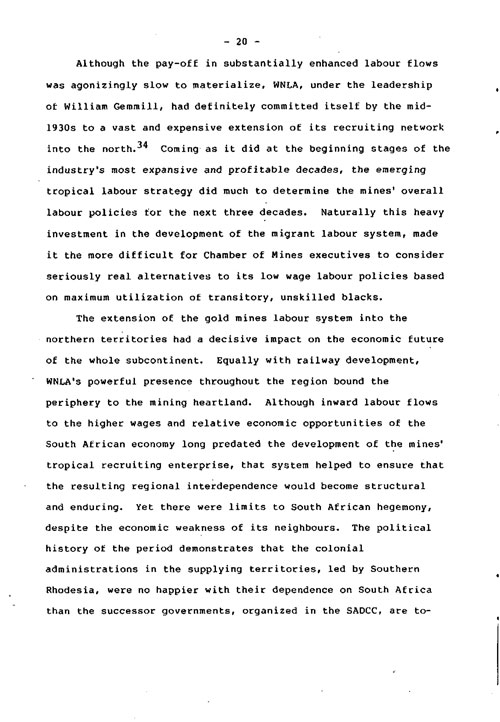
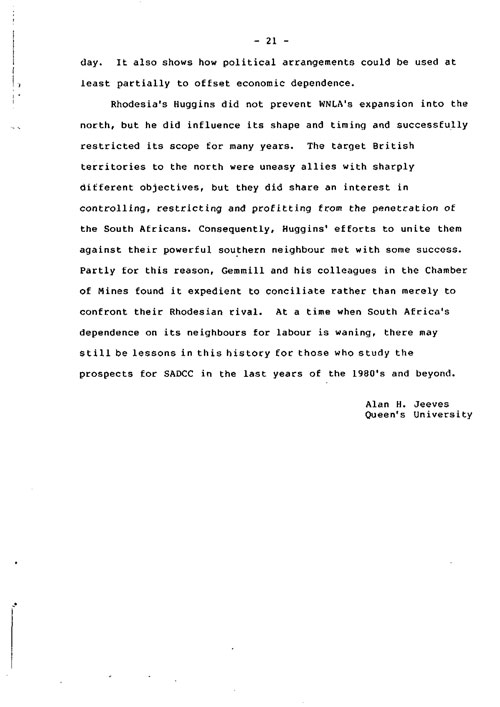


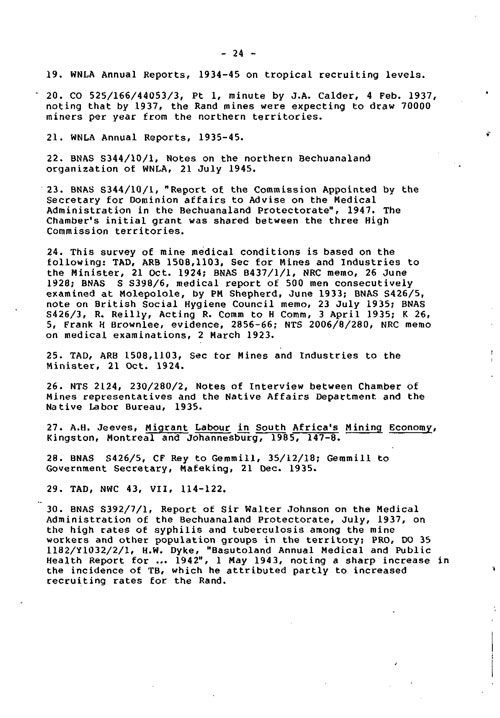
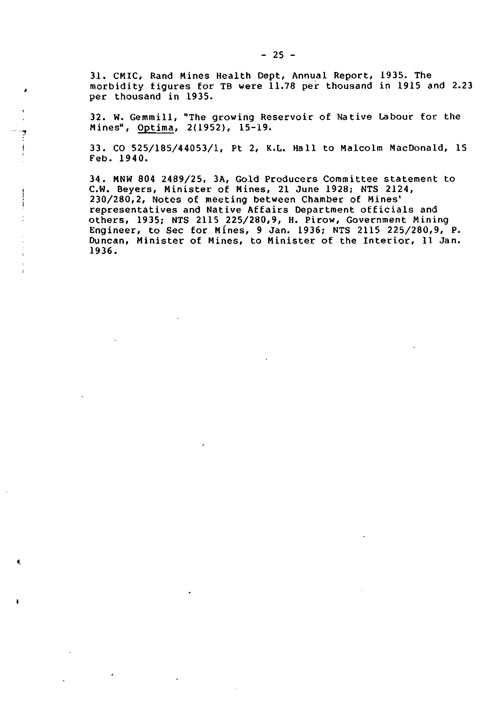
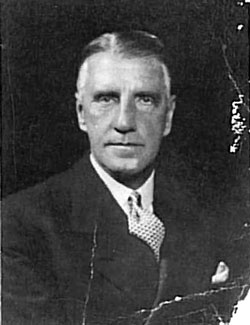
William Gemmill and South African Expansion, 1920-1950
William Gemmill was one of South Africa's most influential mining leaders. As administrative head of the Transvaal Chamber of Mines, he, more than anyone, shaped the industry's policies with regard to both white and black labour throughout the whole period from the 1920's to the 1950's. His importance rivalled or exceeded that of H.M Taberer, the General Superintendent of the Native Recruiting Corporation until the early 1930's, and influential government officials such as Sir Robert Kotze, the Government Mining Engineer, 1910-26, or his successor, Hans Pirow. Gemmill worked closely with other top officials, notably with H. Warington Smyth, the Secretary for Mines and Industries in the 1910's and 1920's, and Douglas Smit, the influential Secretary of Native Affairs in the 1930's and 40's. None of their careers have been adequately studied. Most of them have not been studied at all. Like these men, he was a bureaucrat rather than a capitalist. Like them, his extraordinary length of tenure and thorough familiarity with mining and labour matters frequently gave him decisive influence on policy. Gemmill's power depended largely on personal qualities. As a Chamber of Mines functionary, he held his position at pleasure. He did not have the backing of one of the big mining houses. He did not command a large personal fortune. Until the end of his career, he remained an official of the Chamber of Mines and subject to the control of its Executive Committee.
- 2 - Very little has been written about Gemmill. He does not appear in the first four volumes of the Dictionary of South African Biography. There is no reference to him in Gregory's Oppenheimer or Cartwright's The Golden Age and Gold Paved the Way. Francis Wilson has a single reference to Gemmill, concerning his move to Salisbury toward the end of his career. He does not appear in the indexes of the books by Davies, Innes, Johnstone and Lacey. It is only with the publication of David Yudelman's recent book that the key role of William Gemmill has begun to emerge. Even so, Yudelman focused exclusively on the problem of white labour. If anything, Gemmill had an even larger influence on the shaping of the black labour strategies of the period.1 An understanding of Gemmill's role is important in assessing the extent and limits of the power of mining capital in these decades. His career reveals the way in which the mining industry had become bureaucratic in organization and control. To a large degree it was the functioning of this administrative machinery and its close relations with the state bureaucracy that determined how mining policies on labour and other matters were made and implemented. As historians seek to disaggregate "mining capital" and to analyse policy-making in the industry, as a crucial dimension of the role of classes in South Africa, considerable emphasis must be given to the role of officials. Because of the post he held, Gemmill had to be concerned with the welfare of the mining industry as a whole not with that of any particular group. Concentration of wealth and power among
- 3 - the mining groups had been somewhat diluted since the 1890's. Central Mining/Rand Mines, the once dominant force in the Chamber, was clearly in decline by the 1930's, though still powerful. Anglo-American, the coming power, had yet to achieve commanding influence it was to secure with the opening of the Free State fields. Consolidated Goldfields and J.C.I. were large, independent operators. This relative balance between several key players in the Chamber executive probably worked to the advantage of an astute official like Gemmill. The General Manager's responsibilities in the Chamber bureaucracy tended to make him an advocate of stability and continuity on policy matters. No entrepreneurial gambler, he consistently stood for policies which would ensure slow but steady expansion with minimum risk. In black labour policy, he became an early advocate of tropical recruiting. He perceived that in the distant tropical areas, the gold mines would face local competitors who could not afford to match the industry's low wages. He saw, furthermore, that few, if any, South African competitors could afford to deploy the elaborate recruiting system which the mines had already developed for South Africa and southern Mozambique. Also, he manoeuvred adroitly to attract the support of state diplomacy in dealing with neighbouring governments, especially Southern Rhodesia, to ensure that mining objectives were secured. In these ways, the industry obtained a pre-emptive option on the very large, still untapped supplies of tropical labour, denied them to competitors and ensured the stability of the supply for years to come. The effect of this
- 4 - was to make it much harder for anyone, inside the industry or outside of it, to conceive of any alternative to migrancy. The way in which the Chamber bureaucracy functioned helps to explain Gemmill's extraordinary influence over the development and implementation of black labour policy. As General Manager,
he was the reporting link for executives of the Chamber’s recruiting arm, the Native Recruiting Corporation (NRC) and the Witwatersrand Native Labour Association (WNLA). The recruiters reported to the Chamber's policy executive, the Gold Producers'
Committee, through Gemmill, who functioned, therefore, as chief recruiter. In this capacity, he frequently went on tour of the recruiting stations; personal knowledge of operations in the field strengthened his hold on policy decisions at the centre of operations in Johannesburg. On most matters connected with
labour, Gemmill handled the negotiations with government, both the Union administration and neighbouring authorities. The Portuguese respected him; the Rhodesians feared his power; and even the United Kingdom High Commissioner was wary of the
Chamber.2 Within South Africa during the 1920's, Gemmill worked assiduously to strengthen the hold of the NRC over the principal recruiting zones in the eastern Cape and the northern Transvaal. With a recruiting monopoly at last in place by 1919, the industry could now rationalize its labour system and achieve the economies which it had long been seeking. Gemmill presided over the introduction of two important policy changes which in different ways demonstrated the dominance which the Chamber had now
- 5 - achieved in the recruiting world. First, he supported the introduction of a nine-month minimum contract for recruits. Since the early years of the century, the mines had allowed South African recruits to sign six-month contracts (Mozambique workers served much longer). These were inefficient since the worker had barely time to learn his task before the contract expired. Short contracts meant higher labour turnover and therefore increased recruiting costs. The nine-month contract promised to produce very significant economies. The price of this was paid by the workers and their families in reduced flexibility and a longer commitment away from the peasant economy. The recruiters also paid in the form of a reduced number of recruiting fees. Without the prior elimination within the industry of competitive recruiting, these longer contracts would not have been possible. That the mines could add fifty per cent to the contract length also indicated that they were now more competitive in relation to other employers. The second measure introduced by Gemmill also demonstrated the growing power of the industry to command its labour supply on terms of its own choosing. Gemmill personally presided over the introduction of the Assisted Voluntary System in the late 1920's. Voluntary (unrecruited) labour had been an important factor in the mines' South African labour supply since about 1909-10. This was a popular option because it gave the worker freedom from the recruiter and freedom to choose his employment on arrival. The mines would often give the voluntary worker a very short contract. However, the voluntary system required the worker to
- 6 - find his own way to Johannesburg. He needed money for transportation and food en route, and he needed experience and knowledge of the complex, dangerous world of the Rand. This meant that many workers, especially the totally impoverished, the inexperienced and the merely timid, continued to seek out the recruiters.3 To give these categories of workers an alternative to the recruiters, the industry developed the AVS which provided small advances in rail fare and food in return for mine work at the industry's standard minimum contract. The AVS worker could choose the mine where he would work, a very important consideration. Still wary of totally alienating the recruiters, Gemmill introduced the AVS slowly, concentrating first on the districts where the voluntary system had been most developed (and therefore the power of the recruiters weakest) and then extending the system gradually to other areas in the 1930's. Essentially a form of recruitment, the AVS worked to bind the voluntary to the mines (against rival Rand employers) and to cut out the recruiter-middlemen. The effect of these two measures, the longer contract and the AVS, was to reduce recruiting costs I significantly and to strike a powerful blow against the position of the trader-recruiters. In Mozambique by contrast, Gemmill had not been nearly so successful in producing results favourable to the industry. After many years of intermittent negotiations, the Union government and the Chamber succeeded in renegotiating the Transvaal-Mozambique Agreement of 1909. The revised Mozambique
- 7 - Convention was approved in 1928 on terms which represented significant concessions to the Portuguese. The South African negotiators accepted a ceiling of 80000 workers who could be recruited annually in Mozambique (down from the prevailing average of roughly 100000 per year) and shorter contract periods. The Portuguese also extracted from the Union a pledge to take effective action against the large flow of illegal immigrants who came annually across the border and who mainly ended up on Union farms. The effect of these measures was to threaten a labour shortage not only on the mines but also in the agricultural lands bordering Mozambique. As a consequence, heightened competition for labour between the mines and farms quickly developed. Gemmill and his colleagues countered by negotiating a so-called Gentleman's Agreement with the Natal sugar estates. Within a few years, they were also able to get the Portuguese quota lifted and the ban on clandestine immigrants eased. By then, however, important new gold discoveries on the Far West Rand, the West Wits Line, promised to add substantially to the industry's overall unskilled labour requirements. These developments provide the background to the Chamber's renewed demands after 1928, that its access be restored to the populous recruiting areas north of 22°SL.4 Employment of “tropicals,” had been banned on gold mines because of the disastrous rates of mortality experienced by them prior to 1913. After 1920, the Chamber resumed an active campaign to enlarge its labour supplies and expand its influence in the northern regions. This development in turn worked to
- 8 - entrench further the migrant labour system. The industry's Mozambique recruiting organization, WNLA, became the principal instrument of renewed expansion; by the 1940's, its influence extended throughout southern Africa. WNLA's expansive thrust into the north had important implications for the domestic supply of black labour and for the relations between the mines and other employers. The gold industry's need to enlarge its labour supply derived from the twin stimuli of rapid economic expansion after 1932 and important new gold discoveries. Major consequences followed both for the development of government labour policies and for South Africa's relations with its neighbours. Gemmill's analyses and the requirements of the Chamber of Mines were very influential in shaping the regional labour and immigration policies of the Union government during this period. Through their London representatives, the Johannesburg mining houses put pressure on the Colonial and Dominions offices for support of their access to central African labour. They worked to the same end through the United Kingdom High Commission in Pretoria5 The portrayal of WNLA as the champion of free labour was also vigorously and successfully pushed by the mines' representatives in London and at the international labour Office in Geneva.6 Yet for all its economic power there remained very definite limits on the political influence of the Chamber of Mines. This was true in the regional context as in South Africa itself; the farming lobby had a vital interest in the tropical labour issue, and the Union government always showed itself highly sensitive to farmers' needs. Northern Transvaal and
- 9 - Zululand planters had come to rely on clandestine alien labour. They resisted the implementation of any change which seemed likely to reduce, much less prevent, their access to this important source. Thus control of this large flow of labour toward South Africa became a focus of controversy within the country in the 1930's. As early as 1928, the Chamber began to lay its plans for expansion into the north.7 In that year, WNLA sent one of its senior employees on tour into the trans-Zambesi. Travelling by auto, rail and ferry, P. Neergaard saw huge areas of Nyasaland, Northern Rhodesia, Tanganyika and northern Mozambique. He returned with glowing reports on the labour potential of these areas and the ease with which WNLA could establish itself in them.8 Armed with these optimistic estimates and, after 1932 with the approval of the Union authorities for a new round of experiments with "tropicals", Gemmill began negotiations with neighbouring governments for renewed access to the northern territories for WNLA recruiters. The discussions with the Southern Rhodesians were extremely tough.9 "If Mr. Gemmill is not appeased the Witwatersrand can entice labour without any conditions at all", concluded Southern Rhodesia's Secretary of Native Affairs10 This same official earlier referred to the "chaotic state of scrambling for labour on our borders". 11 He feared that "the labour war has begun"12 and that the activities of WNLA would soon result in generalized competition as rival employers within Southern Rhodesia fell upon each other. Not only would the colony's long-established
- 10 - dominance in the adjacent parts of Nyasaland and Northern Rhodesia be placed at risk but also its hard-won controls on the domestic Rhodesian labour market would now be threatened with disruption. Local employers would certainly to try to emulate WNLA's aggressive ways and probably to attack each other rather than the much more powerful WNLA. The larger employers could look after themselves but the smaller ones would be driven out of the labour market. Moreover, existing high rates of "leakage" of unrecruited "voluntaries" to the Union left little doubt that active recruiting by an agency as formidably well-financed and organized as WNLA would succeed in stripping the tropical areas of much of their labour. By the later 1930's, the Southern Rhodesian government had developed harsh countermeasures to Union pressure on its labour supplies. This reflected official recognition of the weakness of Southern Rhodesia's competitive position in the looming struggle for labour. Not only were the Rhodesians losing their own labour, but also they were losing control of their traditional outside sources, as migration flowed increasingly to the subcontinental poles of the mining economy, the Copperbelt and the Rand. To try to interdict the southern stream, Huggins put legislation through Parliament in 1938 to exclude Africans without passes from a defined twenty-five mile zone along the colony's Limpopo border with the Union. Motorcycle police would patrol this cordon sanitaire intensively, and lorry transport services used by the migrants would be curtailed and monitored for clandestine emigrants. Although never implemented, this measure was dramatic
- 11 - evidence of the lengths to which the Rhodesians were prepared to go in order to protect their labour. It was meant as a threat and taken to be one, as subsequent negotiations with the South Africans showed. The Prime Minister and his colleagues were by no means content with a defensive strategy in these years. They moved vigorously to compete with WNLA in the prime recruiting zones of central and northern Nyasaland. Rest camps were established along the main transport routes and an elaborate lorry service created. They opened negotiations with the Northern Rhodesian government to place steamers at crossing points on the Zambesi so that part at least of the labour flow could be diverted from the WNLA base at Kazungula.13 They also used patriotic and Imperial arguments to prevail on their northern colleagues to give preference to Rhodesian employers over those of the Union, claiming that otherwise the central African territories would inevitably fall into the economic (perhaps even the political) orbit of South Africa.14 While Huggins failed to exclude the Rand recruiters from Rhodesia's main recruiting preserves, his diplomacy did slow the South Africans down and contributed to the slow growth in the number of WNLA tropical recruits. By agreeing to talk to Gemmill and his agents, colonial governments in the target areas, especially Southern Rhodesia, managed to restrain WNLA's demands and to secure some agreed limits on the total outflow of labour to the south.15 The interests of Nyasaland and Northern Rhodesia, of course, differed from those of Southern Rhodesia. With an acknowledged labour
- 12 - "surplus", limited local employment opportunities and depressed economies, they were very much alive to the revenue implications of Gemmill's approaches. Furthermore, they knew that southern Rhodesia was getting their labour at bargain rates, and they were not averse to its employers having to respond to competition from the formidable WNLA.16 Still, both governments had to contend with settler and planter lobbies, not to mention Copperbelt mine owners in the case of Northern Rhodesia, who feared the inevitable pressure to raise wages which WNLA would bring. The Nyasaland government especially also professed alarmed at the disruptive social effects which large scale migration of the adult males had already caused in some districts.17 Such arguments in the hands of officials must be treated with caution, however. Local settlers also used them to cloak their determination to protect their privileged access to semi-servile black farm labour.18 While the amounts of recruited labour to the mines from the Tropical regions were small up to 1939 (less than 10 per cent of the total supply), WNLA and the Chamber considered that their commitment to this enterprise was an investment for the future. As the industry's recruiting experts saw the problem, their expanding needs could only be met from outside the Union and Mozambique. There were many signs that the gold mines were increasingly uncompetitive in South Africa's own labour markets; and the potential of the southern parts of Portuguese East Africa had been pretty much fully tapped,20 It is not surprising that Gemmill and his associates would turn their attention to the
- 13 - tropical northern areas. Hence the later 1930's and 1940's saw WNLA and the Chamber of Mines committing large funds to the development of transport networks (road and air), rest camps and medical facilities which would enable them to exploit the labour resources of these target areas.21 In northern Botswana, WNLA's contribution to basic economic infrastructure was enormous, reflecting the association's understanding of the strategic significance of the territory. Not unimportant itself as a potential source of new recruits, Bechuanaland was vital as the mines' recruiting highway around the Rhodesians into the north and north-west. As the mining economy entered its most expansive decades, Bechuanaland regained much of the strategic significance it had had in the heyday of Imperial expansion in the 1880's and 90's. Rhodesia's Huggins had indicated from the start that he would do everything possible to thwart WNLA's plans and to impede the flow of labour from and through his colony. Communications were difficult through Mozambique. This left Bechuanaland. Even when negotiations with the Rhodesians produced agreements between 1936-9, WNLA's stake in Bechuanaland remained important as a standing demonstration that from this base, with or without the cooperation of the other governments, the Association could tap the labour supplies of the entire region. From its new depot at Francistown, it built roads north to Kazungula at the confluence of the Chobe and the Zambesi rivers and west to Ghanzi (continuing eventually to Grootfontein in South West Africa) across the central Kalahari where only tracks
- 14 - had existed before.22 it was WNLA and not the colonial government that opened the modern road from Francistown to Maun and from there to Mohembo on the Okavango River. Eventually, WNLA had constructed over 800 miles of roads in northern Bechuanaland alone; and had in addition established motor barge transport on the Zambesi and through the Okavango. This major contribution to infrastructure was paralleled by similar activities in northern Nyasaland and Barotseland. The Chamber of Mines underwrote the expansion of colonial medical services in Bechuanaland and the other High Commission Territories with modest grants-in-aid to support the training of paramedical staff and the establishment of mobile clinics. This was partly to improve the chronically poor health of the target population, numbers of whose males would now have to meet the medical standard established by WNLA for mine recruits. Loss of labour through medical rejection was wasteful in itself but it also affected the willingness of all blacks to come forward from long distances when there was a high risk of being turned back on health grounds. Clearly also, the Chamber sought by its grants-in-aid to cultivate the goodwill of the impoverished authorities at Mafeking.23 Despite major improvements in hospital and other medical facilities on the mines, black miners remained at serious risk from continuing high rates of illness and accident.24 While the banning of tropical recruitment in 1913 led to sharp falls in the incidence of pneumonia, tuberculosis and other lung ailments continued to exact a heavy toll. Since few of the black miners
- 15 - served long or continuously enough to contract miners' phthisis the elaborate precautions mandated by the state under successive Phthisis Acts benefitted exclusively the white mine workers. Reviewing the state of health legislation and policy in 1924, the Secretary for Mines drew attention to the inadequate precautions against tuberculosis that were taken by the companies when engaging black mine workers. ... It is computed that during the past twenty years, an ARMY of 20,000 OR MORE tuberculous NATIVES [sic] have been discharged by the Mines and sent back to their Kraals to spread the disease amongst the millions of their race, while quite 10,000 must have found employment in other industries and with Europeans during the same period of twenty years....I am informed by competent authority that this terribly dreaded disease which is both infectious and contagious is absolutely rampant amongst the natives in our country and it seems that the position is seriously aggravated by hosts of tuberculotic natives who are sent back every year {by the mines] to their kraals to carry the contagion. The position is too dreadful to think about. 25 What-made the deficiencies in the mine medical examination and the lack of a routine X-Ray screen particularly serious was the poor health of the target population. Evidence available to industry medical officers suggested that general health in the labour pools from which the mines were drawing continued to decline. By 1934, roughly twenty per cent of Transkeian Africans examined failed the mine medical, though it remained substantially unchanged from the cursory, unsatisfactory examination condemned by the Secretary for Mines ten years earlier. During 1934, something like 20000 workers in the Transkei alone were rejected for mine work. About another five thousand failed the medical at the WNLA compound on arrival in
- 16 - Johannesburg. Most of these would be given surface work since the immediate return of rejected workers caused adverse comment in the territories and hurt recruiting. Under pressure from the Native Affairs department to increase employment of Transkeian Africans, Chamber representatives declined to authorize the NRC to recruit for the Natal sugar and wattle planters (outside the malarial zone) but did say there would be no objection to recruiters from the estates being present at the medical to offer immediate employment to the rejects.26 The proposal merely regularized what had been going on routinely throughout the Union on an informal basis. Since the mines paid more than the farms, they got the pick of the fit labour. The sick, the weak and those too young or too old went to the farms. This pattern would be repeated as the industry now began to extend its recruiting effort into the north.27 Routine X-Ray chest examinations of workers not suspected of lung disease were not a regular part of the medical programme, indicating that costs remained a key determinant of policy. During 1935 when the debate on tropical labour was at a critical stage, a significant exchange of correspondence took place between William Gemmill and C.F. Rey, the Resident Commissioner of Bechuanaland.28 On the recommendation of his principal medical officer, Rey argued that the mines should provide an X-Ray screen for all returning mine workers so that cases of TB might be caught at the very earliest stages when treatment and isolation were most likely to prevent the spread of
- 17 - the disease. Refusing this, Gemmill and his colleagues argued in effect that TB was not a "mining disease" and that their medical officers should not have special responsibility to treat it. As late as 1943 Gemmill told the Lansdown Commission on African mine wages that there was no serious health problem in the "native territories" for the mines to be concerned about. It was a typically brazen performance which the Commission easily refuted on the basis of public information.29 Every contemporary study demonstrated that in all of the recruiting areas, tuberculosis was a major menace to the mines' target population and migration to the Rand a principal source of infection and reinfection.30 When Industry spokesmen were prepared to admit this, they denied the conclusion that found the mining industry mainly responsible.31 Without question routine X-Ray examinations would have reduced the incidence of infection of mine workers both on the mines and after they were at home. The further spread of the disease would in this way have been checked. It would also have dramatically increased costs, both for the examinations themselves and even more for the treatment which would have been necessary. To say that this step would have been expensive was correct; to argue that it was "wholly unnecessary" was seriously at variance with known facts. Although its medical facilities and health precautions far exceeded those provided to blacks either by government or other employers anywhere in southern Africa, the gold industry declined to take all of the health precautions that were available to it and found a variety of "sociological", economic and medical reasons to justify this.
- 18 - Eventually, in the 1940's the Chamber reversed itself and introduced a comprehensive X-Ray screen. 8y the end of the 1930's, WNLA had the key elements of its northern strategy in place and accepted by the northern governments. It established a regional headquarters in Salisbury and concluded a formal agreement with the colonial administrations of Southern Rhodesia, Northern Rhodesia and Nyasaland. This gave the association the right to establish its depots, camps and transport systems throughout Barotseland and northern Nyasaland. In return, Gemmill undertook that the mines would not engage northern "voluntaries" within South Africa itself." This was an extremely important concession. The northern governments knew that the mines were the magnet for most of their clandestine migrants, thousands of whom never returned, becoming the so-called "lost ones". The 1939 agreement offered a means of checking that unregulated flow of labour, much of it permanently lost to the supplying territories, which neither police border patrols nor pass laws and other controls had been able to contain or prevent. By arrangement with the Chamber this labour could now be diverted into WNLA channels with repatriation at the end of the contract period guaranteed. What the governments had been unable to do with their police, what they had failed to persuade the Union to accomplish with its forces, might now be achieved by agreement with WNLA. To the Chamber of Mines, labour was a resource like any other; a territory which failed to develop this resource should not be allowed to retain it.
- 19 - These dealings between Gemmill and the northern colonies had implications which were equally serious for WNLA's South African competitors, especially the mines and farms of the northern Transvaal. Many of the clandestine immigrants, although intending to travel as quickly as possible to the gold mines, in fact ended up working for farmers as soon as they crossed the Limpopo. Either they never got to the gold mines at all or would do so only after an interval of very low-wage employment on some border farm or mine. During the 1930's, the Union had established depots and police patrols to catch as much as possible of this labour and force it either to accept local employment or to be put back across the border. Although ineffective in stopping the inflow into the Union, these police measures did force many of the immigrants to seek shelter in uncongenial, low wage employment on some local farm or mine.33 Private recruiters prowled in these regions touting for labour on behalf of individual estates and various farming collectives. Now these clandestine migrants, denied any prospect of employment on gold mines by Gemmill's 1939 deal with the three supplying governments unless they accepted recruitment for them in their home territory, would necessarily flow into the channels carefully constructed by the recruiting association. Clandestine migrants could no longer count on mining employment even if they did succeed in running the gauntlet of predatory farmers and labour touts in the border areas. WNLA had managed to divert at source part of the migration which formerly had provided northern Transvaal and Zululand farmers with much of their labour.
- 20 - Although the pay-off in substantially enhanced labour flows was agonizingly slow to materialize, WNLA, under the leadership of William Gemmill, had definitely committed itself by the mid-1930s to a vast and expensive extension of its recruiting network into the north.34 Coming as it did at the beginning stages of the industry's most expansive and profitable decades, the emerging tropical labour strategy did much to determine the mines' overall labour policies for the next three decades. Naturally this heavy investment in the development of the migrant labour system, made it the more difficult for Chamber of Mines executives to consider seriously real alternatives to its low wage labour policies based on maximum utilization of transitory, unskilled blacks. The extension of the gold mines labour system into the northern territories had a decisive impact on the economic future of the whole subcontinent. Equally with railway development, WNLA's powerful presence throughout the region bound the periphery to the mining heartland. Although inward labour flows to the higher wages and relative economic opportunities of the South African economy long predated the development of the mines' tropical recruiting enterprise, that system helped to ensure that the resulting regional interdependence would become structural and enduring. Yet there were limits to south African hegemony, despite the economic weakness of its neighbours. The political history of the period demonstrates that the colonial administrations in the supplying territories, led by Southern Rhodesia, were no happier with their dependence on South Africa than the successor governments, organized in the SADCC, are to-
- 21 - day. It also shows how political arrangements could be used at least partially to offset economic dependence. Rhodesia's Huggins did not prevent WNLA's expansion into the north, but he did influence its shape and timing and successfully restricted its scope for many years. The target British territories to the north were uneasy allies with sharply different objectives, but they did share an interest in controlling, restricting and profitting from the penetration of the South Africans. Consequently, Huggins' efforts to unite them against their powerful southern neighbour met with some success. Partly for this reason, Gemmill and his colleagues in the Chamber of Mines found it expedient to conciliate rather than merely to confront their Rhodesian rival. At a time when South Africa's dependence on its neighbours for labour is waning, there may still be lessons in this history for those who study the prospects for SADCC in the last years of the 1980's and beyond.
Alan H. Jeeves
Queen's University
- 22 - Notes Abbreviations Used in the Notes ARB Department of Labour Archive BNAS Botswana National Archive, Gaborone: Secretariat Series BRA Barlow Rand Archives, Sandton OMIC Central Mining and Investment Corporation CNC Chief Native Commissioner CO Colonial Office DO Dominions Office GNLB Government Native Labour Bureau K26 Archive of the Native Economic Commission, 1930-2. MNW Department of Mines and Industries Archive NRC Native Recruiting Corporation NTS Native Affairs Department Archive NWC Report of the Commission on Mine Natives' Wages, U.G. 21—1944 (Lansdown Commission) PRO Public Records Office, London SNA Secretary of Native Affairs TAD Transvaal Archives Depot, Pretoria WNLA Witwatersrand Native Labour Association ZA Zimbabwe National Archives, Harare 1. A.P. Cartwright, The Golden Age, Cape Town, 1967; A.P. Cartwright, Gold Paved the Way, London, 1967; Robert Davies, Capital State and White Labour in South Africa, London, 1979; T. Gregory, Ernest Oppenheimer and the Economic Development of South Africa, London, 1962; D. Innes, Anglo: Anglo American and the Rise of Modern South Africa, Johannesburg, 1984; F.A. Johnstone, Class Race and Gold, London, 1976; M. Lacey, Working for Boroko, Johannesburg, 1981; F. Wilson, Labour in the South African Gold Mines, Cambridge, 1972) D. Yudelman, The Emergence of Modern South Africa, Westport, 1983. 2. TAD, NTS 2006/8/280, Geramill to Garthorne, 24 July 1928; CNC S1561/5 to PM, Dec. 1938; BNAS 437/1/2, E. Baring to Hon. Philip Noel-Baker, M.P., Commonwealth Relations Office, 2 Feb. 1948. 3. On the introduction of the AVS see TAD, MNW 802 2489/25, Pt 2, Report of Gemmill's tour of Transkei and Pondoland, Natal and Swaziland, Oct. 1927; MNW 804 2489/25, 3A, clipping from the Rand Daily_ Mail, 10 Sept. 1928; BRA, CMIC Archive, Box 181, CMIC, Jhb. to CMIC, London, 23 Nov. 1927; NTS 2124, 230/280, 2, Louis Gilson, Kokstad to Patrick Duncan, 31 Dec. 1933; NTS 2201 315/280, Native Affairs Dept. memo, 1935 [?]; TAD, K 26, 1930-2, 5, 9, 12, Evidence of B.C. Thompson, H.O. Sayer, Frank Gwoyne, Alfred Roberts, Charles L. Butlin (Manager, Modder B), Harold Mayer, Alfred J. Limebeer, James B. Gedye. 4. NTS 1512 225/280A; /280B; /280, 5; NTS 2202, 315/280, 6, department memorandum, 1935; and S. Katzenellenbogen, South Africa and Southern Mozambique, Manchester, 1982, 149-51.
- 23 - 5. PRO, CO 525/166/44053/3, Pt 1, Secretary, U.K. High Commission to Malcolm MacDonald, 10 May 1937; NTS 2247 603/280, 4 SNA to Union HC, London, 22 Feb. 192. 6. NTS 2247 603/280, 4, WNLA Statement to the ILO, 27 Sept. 1951; NTS 2247 603/280, 3, Rand Daily Mail clipping, 13 June 1951. 7. The mines demands for renewed access to tropicals went back to the Low Grade Mines Commission of 1919-20, the Final Report of which endorsed their position, Report, 19-20. 8. MNW 804 2489/25, 3A, P. Neergaard to W. Gemmill, 21 May 1928. 9. For example, ZA, CNC S1561/4, W. Gemmill to K.J Stanley, Governor, Southern Rhodesia, 15 Dec. 1937? CNC S1561/3, summary of Prime minister's file on labour, 1936. 10. CNC S1561/5 to PM, Dec. 1938. 11. CNC S1561/4 to PM, 15 Nov. 1937. 12. CNC S1561/5 to PM, Dec. 1938. 13. CNC S1561/5, Governors' Conference Proceedings, 5-6 Feb. 1939. 14. CNC S1561/50, SNA to Huggins, 20 July 1938. 15. CO 525/161/44053/3/1936, minute by J.A. Calder, 3 Nov. 1936. 16. CNC S1542/L1/1933, J.M. Thompson, SNA, Northern Rhodesia to Col. Carbutt, CNC, Southern Rhodesia, 13 Nov. 1933 and CNC S1561/5, SNA of Southern Rhodesia, reporting the views of the northern governments, 29 Nov. 1938. In Salisbury, the Governor informed London that Sir Harold Kittermaster in Zomba seemed "obsessed" with sending as much labour to the Rand as possible. Since Kittermaster's proposals were in fact quite modest, one evidently did not have to do very much to earn that reputation in Salisbury. CO 525/173/44053/3, Pt 1, Herbert Stanley to Sir E. Harding, 24 Dec. 1937. 17. CO 525/158/44053/1935, Kittermaster to MacDonald, 29 May 1936; and CO 525/161/44053/1936, Kittermaster to Macdonald, 22 July 1936. 18. CO 525/161/44053/ 1936, "Report of the Committee Appointed by His Excellency the Governor to Enquire into Emigrant Labour, 1935" (Zomba, Government Printer, 1936). In the following year, however, some of the Nyasaland planters suggested trading Nyasaland labour for duty free access to Union markets for their tobacco. CO 525/173/44053/3, Pt 1, Herbert Stanley to Sir E. Harding, 24 Dec. 1937.
- 24 - 19. WNLA Annual Reports, 1934-45 on tropical recruiting levels. 20. CO 525/166/44053/3, Pt 1, minute by J.A. Calder, 4 Feb. 1937, noting that by 1937, the Rand mines were expecting to draw 70000 miners per year from the northern territories. 21. WNLA Annual Reports, 1935-45. 22. BNAS S344/10/1, Notes on the northern Bechuanaland organization of WNLA, 21 July 1945. 23. BNAS S344/10/1, "Report of the Commission Appointed by the Secretary for Dominion affairs to Advise on the Medical Administration in the Bechuanaland Protectorate", 1947. The Chamber's initial grant was shared between the three High Commission territories. 24. This survey of mine medical conditions is based on the following: TAD, ARB 1508,1103, Sec for Mines and Industries to the Minister, 21 Oct. 1924; BNAS B437/1/1, NRC memo, 26 June 1928; BNAS S S398/6, medical report of 500 men consecutively examined at Molepolole, by PM Shepherd, June 1933; BNAS S426/5, note on British Social Hygiene Council memo, 23 July 1935; BNAS S426/3, R. Reilly, Acting R. Coram to H Comm, 3 April 1935; K 26, 5, Frank H Brownlee, evidence, 2856-66; NTS 2006/8/280, NRC memo on medical examinations, 2 March 1923. 25. TAD, AR8 1508,1103, Sec tor Mines and Industries to the Minister, 21 Oct. 1924. 26. NTS 2124, 230/280/2, Notes of Interview between Chamber of Mines representatives and the Native Affairs Department and the Native Labor Bureau, 1935. 27. A.H. Jeeves, Migrant Labour in South Africa's Mining Economy, Kingston, Montreal and Johannesburg, 1985, 147-8. 28. BNAS S426/5, CF Rey to Gemmill, 35/12/18; Gemmill to Government Secretary, Mafeking, 21 Dec. 1935. 29. TAD, NWC 43, VII, 114-122. 30. BNAS S392/7/1, Report of Sir Walter Johnson on the Medical Administration of the Bechuanaland Protectorate, July, 1937, on the high rates of syphilis and tuberculosis among the mine workers and other population groups in the territory; PRO, DO 35 1182/Y1032/2/1, H.W. Dyke, "Basutoland Annual Medical and Public Health Report for ... 1942", 1 May 1943, noting a sharp increase in the incidence of TB, which he attributed partly to increased recruiting rates for the Rand.
- 25 - 31. CHIC, Rand Mines Health Dept, Annual Report, 1935. The morbidity figures for TB were 11.78 per thousand in 1915 and 2.23 per thousand in 1935. 32. W. Gemmill, "The growing Reservoir of Native labour for the Mines", Optima, 2(1952), 15-19. i 33. CO 525/185/44053/1, Pt 2, K.L. Hall to Malcolm MacDonald, 15 Feb. 1940. 34. MNW 804 2489/25, 3A, Gold Producers Committee statement to
[ C.W. Beyers, Minister of Mines, 21 June 1928; NTS 2124, 230/280,2, Notes of meeting between Chamber of Mines' representatives and Native Affairs Department officials and others, 1935; NTS 2115 225/280,9, H. Pirow, Government Mining Engineer, to Sec for Mines, 9 Jan. 1936; NTS 2115 225/280,9, P. Duncan, Minister of Mines, to Minister of the Interior, 11 Jan. 1936.
William Gemmell married Kathleen Russell, nee Stoney Archer. For more photographs of him click
here.

